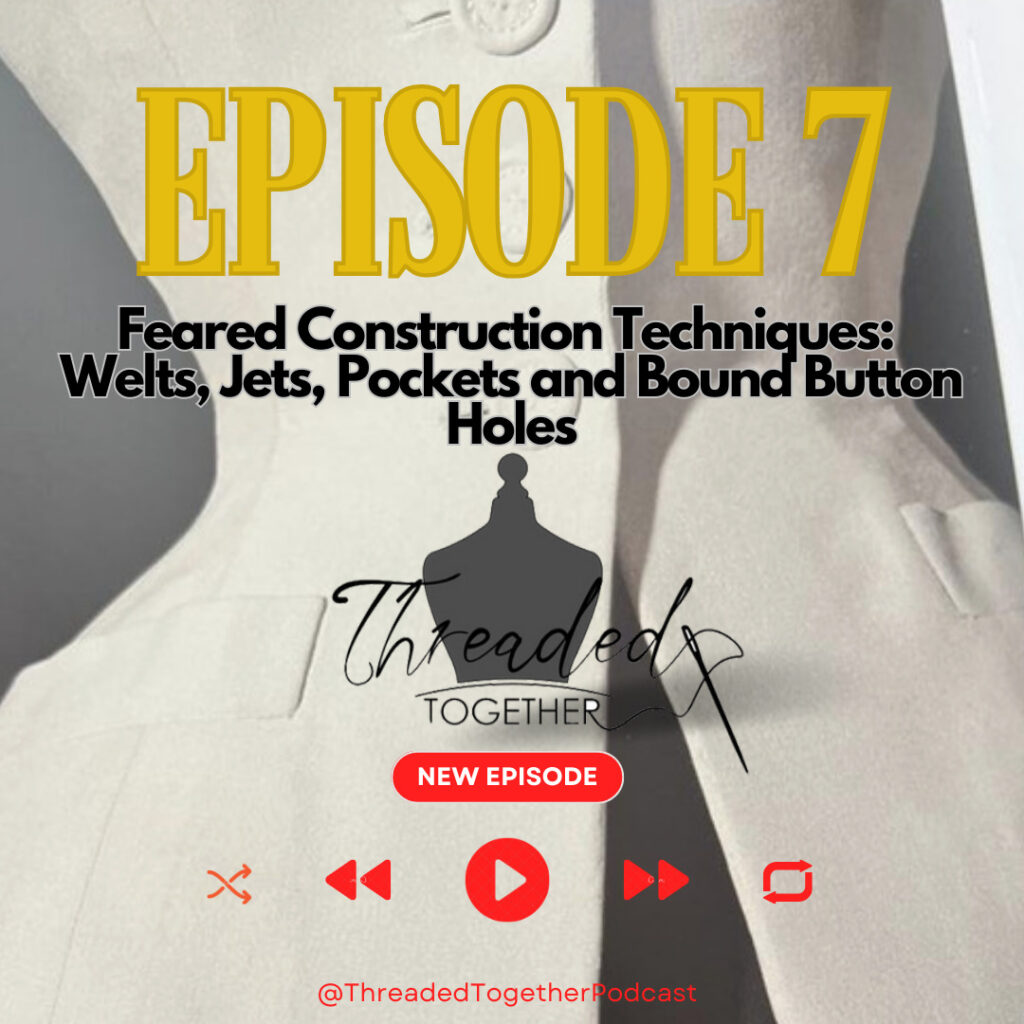
As the crisp air heralds the arrival of autumn, our thoughts turn to cozy projects and wardrobe updates. Your hosts of Threaded Together, Tracy & Rebecca, are here to guide you through the essential elements that grace our garments, especially during this season. Join us for a deep dive into the intricate world of garment construction techniques, ones that both elevate your creations and present unique challenges – often earning the title of the most feared sewing feats.
What We’ve Been Working On

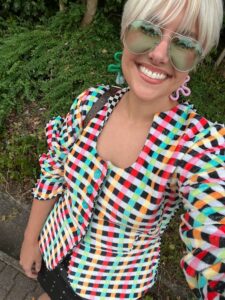
In an inspired turn of events, both Rebecca & Tracy completed their own Barbie inspired outfits to wear to see the Barbie movie now out in theaters. We discussed the topic during last month’s episode, Episode 6, but neither of us actually thought we would actually get our projects done in time! Tracy used the BIANCA Flight Suit Pattern from Closet Core Patterns. For more on Rebecca’s couture inspired jacket process, from drafting the pattern to bound button holes in terry cloth (we don’t recommend trying this yourself) check out the full youtube video of the process!
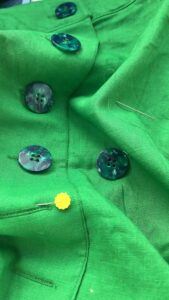
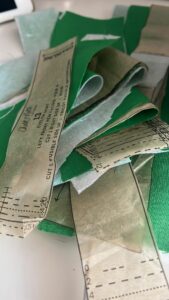
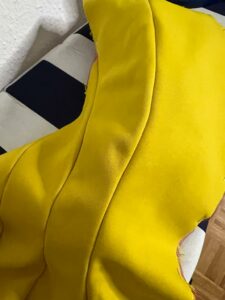
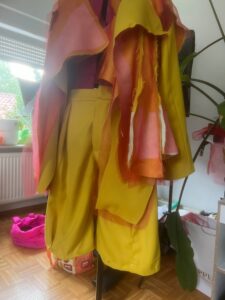
Above, Tracy’s green skirt in it’s work in progress state and Rebecca’s Dior inspired jacket and tailored shorts, still in progress.
In this episode, we embark on an exploration of pockets, welts or jets, collars, and buttonholes: features that can reveal a beautifully crafted garment and have the power to transform an ordinary piece into a fashion statement. In this episode we will demystify these components, sharing what they are, their prevalence in the world of ready to wear and of course our tips for how to execute them successfully in your own sewing projects.
At Threaded Together, we take pride in not only fostering your sewing talents but also in weaving the tapestry of fashion history and contemporary trends. We delve into Copenhagen Fashion Week, savor the rich flavors of historical fashion narratives, and explore the latest gems from the Victoria & Albert Museum in London. Tune in to discover, learn, and be inspired. And remember, as we stitch together the realms of home sewing, high fashion, and garment construction we are shaping a sustainable future we want to live in. Keep those threads humming and those ideas blooming! – T&R
Pockets
“Pockets are important: they can beautifully accent a professional seam, or they can blatantly expose a poor construction job.”
– Tracy quoting the Vogue Sewing Book.
We love pockets, but Tracy brings up a great point about when they can be a nuisance, citing @ThriftyStitcher on instagram cutting them out of presenters’ clothing. One might argue however that if the mouths of the pockets are gaping and distracting, perhaps they aren’t the best made/placed pockets? (see quote above…. . . . )
Seam pockets – a pocket where the opening falls along the seam line of a garment – sometimes known as a ‘Secret pocket’ because you can’t see it from the outside.
- Example: Vali dress by Pattern fantastique
Separate in-seam pocket are where the pocket pieces are separate to the main piece and sewn on – this is what we most commonly see in sewing patterns.
- Example: Vogue V9075
Extension in-seam pocket is where there is an extension on the main piece and a separate seam pocket is attached to that.
- Example: Vogue 9511 1970’s jumpsuit pattern
- You can do really fancy in seam pockets – where the side zip on a dress for example also has a pocket! Threads magazine has a tutorial for this: https://www.threadsmagazine.com/2022/01/19/add-a-pocket-along-a-side-seam-invisible-zipper.
Front hip pockets (also known as slash pockets.) You’ll see those as inserts on jeans and boilersuits/dungarees/ and certain trousers where the pocket mouth is set apart from the pocket itself, usually using a facing made out of the self-fabric of the garment.
- A great resource for under stitching the pocket mouth: sewing tutorial for a faced trouser pocket. https://www.thelaststitch.com/tutorial-sewing-a-faced-trouser-pocket/.
Patch Pockets: – a pocket on the outside of a garment. You see this often on more workwear style garments. When you can see the full outline of the pocket on top of your garment, for example a jacket with a patch pocket.
- Friday pattern company has an example of this in their Ilford jacket. They also have a great description of a variety of patch pockets & free downloads of different types of patch pockets
- You also commonly find patch pockets on the back of jeans – of which side note – closet core has a great download of back pocket designs https://blog.closetcorepatterns.com/free-downloadable-33-back-pocket-designs/
Jets / Welts
“In men’s tailoring they are called jetted; in couture they are called ‘piped.”
-Rebecca quoting Claire Schaffer
Jets or Welts on a garment are the use of a separate piece of fabric that is visible at the opening of the pocket and creates a pleasing detail to the eye while also reinforcing the opening. They allow you to put the pocket mouth, or pocket opening, anywhere on the garment without accessing a seam line.
- Our favourite books for resources for detailed techniques – the best for welts are Claire Schaeffer & David Page Coffin
- Claire Shaeffer’s Couture Tailoring
- Making trousers for Men and Women by David Page Coffin
- The Vogue sewing book
- Readers Digest Complete Guide to Sewing
Collars
“A great example of a collar shape driving a trend was actually during covid. The baby-doll dress had a huge moment and with it came a big influx of peter pan collars, the similarly playful, curved flat collars that also gave an almost child-like fun to an outfit. PEter Pan collars got their name by being designed in 1905 for an actress named Maude Adams playing the role of peter pan and the almost circular shaped collar became popular in children’s wear and school uniforms. During covid when dopamine dressing or dressing for one’s own personal enjoyment was at it’s height, adding a circular, statement Peter Pan collar fueled that playful, fun aesthetic as a major trend of the moment. “
-Rebecca
The collar concept is fairly self-explanatory: it’s whatever goes around your neck on a garment. The nature of the place of attachment and the need to either fold a certain way or stand, while going around the significant curve of your neck makes the collar one of the most complex parts of a jacket or shirt.
Collar Tips
- You want your collars/ corners center front openings to be symmetrical
- The underside/undercollar should never show – nor should the seams at the finished edge. When comparing pattern pieces you will often find the under collar is a smidge (technical term! Maybe a ¼ a mm ??) smaller than the top collar to aid it not showing, you’ll also find it a point reiterated in pattern instructions – when pressing you ensure the seams are rolled so you cannot see the undercollar
- Always stitch the collar sections together with the collar grain – starting at the centre then towards the end
- Make sure you trim & grade a collar to reduce bulk. This is particularly important since at the seam line of your collar you have the most layers of fabric coming together at any point in your pattern. Make sure you trim the seam allowance on the under collar, so that you don’t get a ridge or impression showing on the right side of the collar.
- Trim corners as closet to the diagonal as possible on the points of the collar
- A tip you often see on stitching corners on collars is to not sew them at complete right angles but, to sew 2 or 3 small diagonal stitches, or to stitch a diagonal stitch on top of your sewn corner
- If its a curved collar make sure you notch or clip – clip inward (concave) curves and notch outward (convex) curves.
- Depending on the weight of your fabric follow the Interfacing guidelines of the pattern – but a very soft or sheer fabric, or if its a very soft style of collar it may not require interfacing
- Make sure that the weight of the interfacing is compatible with the weight of the dress fabric
What’s Next . . .
Get ready for an exciting upcoming episode where we delve into our favorite designers and their unique mastery in the fashion world. Think Madame Vionnet’s art of draping and Charles James’ innovation with wearable sculpture like the eider down jacket. Expect an enriching blend of fashion history and contemporary connections as we explore these iconic designers and their influence on modern fashion. Whether you’re seeking inspiration for your next creation or aiming to decode references on fashion week runways, this episode is a must-listen.
Share your thoughts, questions, or designer requests by reaching out to us on social media @ThreadedTogetherPodcast or on ThreadedTogetherPodcast.com before the next episode drops. Stay tuned!
DISCLOSURE: The above links may contain affiliate links that provide a commission to the owner of this website if anything is purchased from those links.
